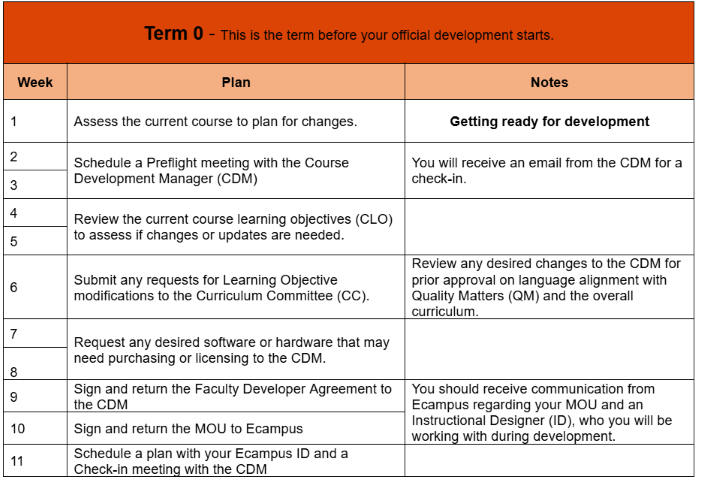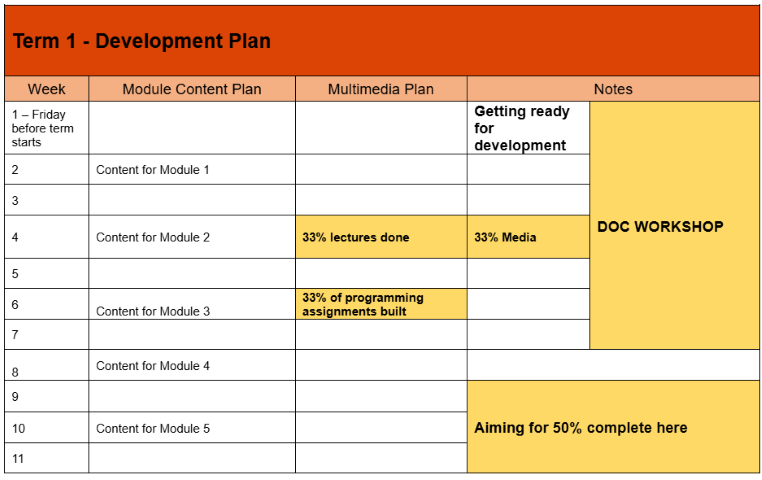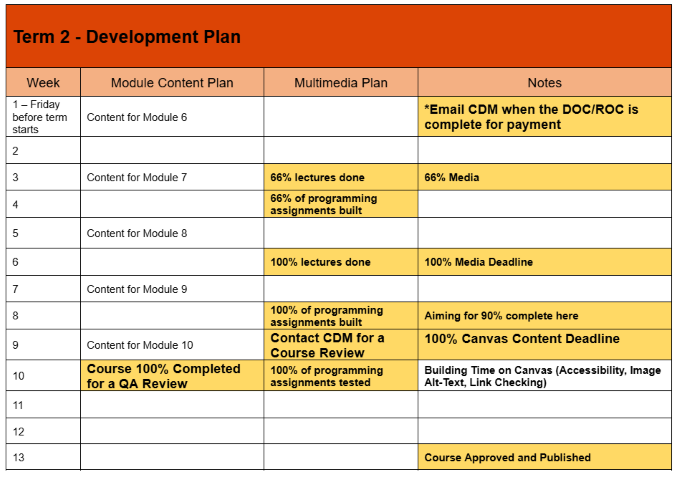This guide has been designed for EECS Online Instructors to use during course revelopment, redevelopment, or continuous improvement. Maintain communication with the Course Development Manager (CDM), your Instructional Designer (ID), and adhere to the Ecampus schedule.
All courses MUST start with the most up-to-date Ecampus template for structure. Those redeveloping a course, you must start with a fresh course template shell and then add your content.
If you have trouble accessing the sandbox site, please request the newest template from the CDM or your Ecampus Instructional Designer.
Term 0: Preparation Phase
Administrative Tasks
- A sandbox is a course without student enrollments where you can create, modify, and preview course content and structure without students on the roster. You can then import your sandbox content into your live course(s). If you are undergoing official development or redevelopment, your ID will create this for you.
Review Course Learning Objectives (LOs)
- Use OSU's updated Bloom's Taxonomy that includes AI concerns.
- Here is an additional resource for applying Blooms to assessments or assignments.
- Limit Course Level LOs to 5-6 broad objectives.
- Ensure LOs are concise, inclusive, and adaptable.
Tips for Creating Learning Objective Language
- Course Learning Objectives should be broad, while Module level Learning Objectives should be more specific
- Clarity & Specificity: Use measurable action verbs (e.g., analyze, design, evaluate).
- Alignment: Ensure LOs align with course goals and broader curriculum.
- Student-Centered: Focus on student achievements rather than teaching processes.
- Achievable & Inclusive: Consider course duration, prior knowledge, and accessibility.
- Scaffolding: Build skills progressively with smaller, manageable objectives.
- Real-World Relevance: Incorporate practical applications to enhance engagement.
Quality Matters Suggestions (v.2025)
- Active vs. Measurable Learning Objectives: Using an Active Verb Isn’t Enough
- Ensure that learning objectives are actually measurable. Some learning objectives might start with an active verb, but may not be measurable.
- Active Verb: Also known as an “action” or “dynamic” verb; describes an action that someone (in this case, a learner) will do or perform.
- Measurable Objective: Describes a specific, observable behavior that can be assessed for quality, completeness, or correctness.
- Active verbs are a starting point, not the finish line.
- Measurable objectives describe clear, observable behaviors or performances that instructors can assess.
- Ask this question: How will learners show that they met this objective, and how will that performance be evaluated?
- Check alignment. Objectives should link to instructional materials and to an activity and/or assessment. Complete your mapping document to ensure all content has a purpose.
- Context matters. Objectives must make sense within the structure of the course and the background of the learners. Even small wording tweaks can make a big difference in clarity and alignment.
Tips for Creating an Accessible Classroom - Complaint with WCAG 2.0 (v.2026)
- Complete an Ally Course Accessibility Report on your course.
- Visit the Accessibility Resource Section in this guide
- Use OSU's updated WCAG Resource for suggestions in improving image ALT-TEXT, creating or converting equations, use of text formatting, visuals in videos, and converting PDF documents where applicable
Term 0 Sample Schedule
 Back to Top
Back to Top
Term 1: Development Phase
Planning & Setup
- Ensure CLOs align with the CIM system.
- Obtain any final CLO modification approvals from CDM and CC if applicable.
- Create Module-Level Learning Objectives (granular and detailed). See Term 0 above for language recommendations.
Term 1 Sample Schedule

*Note that your Instructional Designer with provide an exact delivery schedule. This is just a sample. Condensation of schedules for 1-term developments will be discussed.
Back to TopTerm 2: Finalization Phase
Content Development
- Refer to the media delivery schedule for accessibility preparation.
- Use Ecampus Media Services. *Note that the media deadline is about 4 weeks into term two of development.
- Coordinate with your ID for a DAS and accessibility review for media. See the Course Tools for Tips on developing Accessible Digital content
Course Checks
- Ally for Canvas is an integrated accessibility tool. "Ally scans for and provides instructions on addressing common accessibility issues found in documents and images* uploaded to Canvas."
- Accessibility and Canvas contains "resources to help you get started with improving accessibility in your course content."
- OSU DAS Guide for instructors and advisors.
- The Course AI Resilience Tracker (CART) tool will help you evaluate and enhance the resiliency of your course in the context of generative artificial intelligence tools. The use of the tool is expected to take about a 15 minute time committment.
Term 2 Sample Schedule

*Note that your Instructional Designer with provide an exact delivery schedule. This is just a sample.
Back to TopFirst-Term Launch: Implementation & Refinement Phase
Continuous Improvement
The first term your course is student facing is the most crucial to document any changes or modifications. Below are some tips for documenting your continous improvement efforts:
- Identify Areas of Improvement
- Implement minor changes and improvements, while documenting major improvements for the third-year redevelopment phase.
- Track all changes
- Use course data to measure changes implemented. For example did scores increase? Did participation increase?
- Review Course Analytics and Record Data
- The Canvas Analytics Guide provides a detailed tutorial on the new Analytics feature which displays course data using graphics.
- The Canvas Community Page provides a tutorial using the Analytics feature displaying course data as data tables.
- The OSU Ecampus Canvas Analytics page provides a guide on identifying valuable data.
- This survey should take about 10-15 minutes. Retain a copy for your own records.
-
- Note that you must take the QM Rubrics course to have your course reviewed for QM Certification.
- Registration for all QM Training must occur through our Ecampus Liason through the scheduling link on the Ecampus QM page above.
- View Ecampus QM Online Course Review for more information on the peer review process and certification.
*Documentation of Continuous Improvement supports RSI Efforts, the Prosperity Widely Shared initiative, and improves retention supporting the Every Student Graduates intitiative.
Continuous Improvement Checklist
1.5-Year Mark Review
Analyze changes for the next development cycle
-
- Are students prepared for your course?
- Are they lacking any skills that should be addressed?
- Are pre-requisites still appropriate?
- Have Mastery Paths been considered to test students in Week 0?